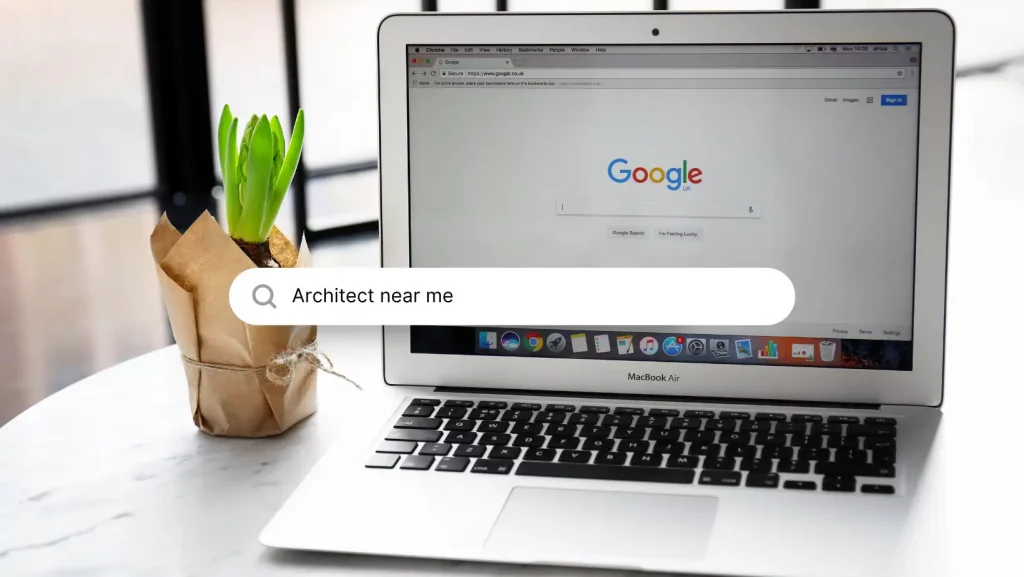An architecture website is a great way to showcase your work, build credibility, and attract new clients. But with so many firms, how can you ensure that your website stands out from the crowd? Here are nine essential elements that will make your architecture website stand out:

1. A Professional Design
Your website is often the first impression potential clients will have of your firm. Make sure it is a good one by investing in a professional design. Work with a web designer specializing in creating websites for architects and make sure your site uses clean, modern lines and incorporates your branding.
Some things to keep in mind when designing your site:
- Your website should be easy to navigate and have a logical flow.
- The design should be clean and minimalistic.
- Incorporate your branding throughout the site.
- Ensure the site is responsive and looks good on all devices.
Investing in a professional design will show potential clients that you are a credible firm that is serious about its online presence. Here are some of our favorite architectural websites for inspiration.
If you need a professional website for your firm, our team here at BlakSheep Creative can help. We specialize in creating beautiful, effective websites for architects. Contact us today, or visit our web design services page to learn more.
2. An Online Portfolio
Another critical element of a successful architecture website is an online portfolio. Your portfolio should showcase your best work and should be updated regularly with your latest projects.
Potential clients will want to see examples of your work before hiring you, so make sure your portfolio is comprehensive and up-to-date.
Some things to keep in mind when creating your portfolio:
- Include a mix of residential and commercial projects (if you specialize in one or the other).
- Include a mix of project types, such as new construction, renovations, and historic preservation.
- Include detailed information about each project, such as the location, square footage, and the number of units.
- Use high-quality images that show off your work in the best light possible.
Having a solid online portfolio is essential for any architecture firm that wants to be successful.
Do you already have a website, but it doesn’t have an online portfolio? Don’t worry. Our team at BlakSheep Creative can help you add one. We’ll make sure it showcases your work in the best light and is easy for potential clients to navigate. Contact us today to learn more.
3. Detailed Project Information
In addition to showing off your work in your portfolio, you should also provide detailed information about each project on your website. Potential clients will want to know all the details about your projects before hiring you, so ensure that this information is easy to find on your site.
At a minimum, you should include the following information about each project:
- The location of the project
- The square footage
- The number of units (if applicable)
- A description of the project
- The type of project (new construction, renovation, historic preservation, etc.)
- The date the project was completed
The more information you can provide about each project, the better. Providing potential clients with detailed information will show them that you are a transparent firm that is proud of its work.
Do you need help with your project descriptions? Our team at BlakSheep Creative can help you write them. We’ll ensure they are clear and concise and paint a picture of your work in the best light possible. Contact us today or visit our copywriting page to learn more about our services.
4. A Blog
Blogging is a great way to attract new visitors to your website and show off your expertise. Writing blog posts about topics related to architecture will show potential clients that you are knowledgeable about the industry and keeping up with the latest trends.
Blogging is also a great way to improve your website’s SEO (search engine optimization). Including keywords in your blog posts can make your site more visible in search engine results, which will help you attract more visitors.

Some things to keep in mind when blogging:
- Include keywords throughout your blog posts to improve your SEO.
- Write about topics that will be of interest to your target audience.
- Include images and videos to break up the text and make your posts more visually appealing.
- Promote your blog posts on social media to reach a wider audience.
Blogs are one of the most critical elements of a successful architecture website. If you don’t have a blog, start one today!
Thinking about starting a blog for your architecture firm, but need help figuring out where to start? Our team at BlakSheep Creative can help. We’ll work with you to develop topics, write the posts, and promote them on social media. Contact us today to learn more.
5. Client Testimonials
Client testimonials are a great way to build trust with potential clients. When someone is considering hiring an architect, they will want to read reviews from past clients to see what their experience was like.
Make sure to include client testimonials on your website. You can create a separate testimonials page or have them on individual project pages.
Some things to keep in mind when gathering client testimonials:
- Only use testimonials from clients that you actually worked with.
- Do not use fake testimonials.
- Include the client’s name, company, and project location.
- Include a headshot of the client if possible.
Client testimonials are essential for any architecture firm that wants to be successful. By showing off positive reviews from past clients, you can build trust with potential clients and increase your chances of being hired.
Do you need help getting testimonials from your clients? Our team at BlakSheep Creative can help you gather them. We’ll work with you to create a process for collecting testimonials that is easy and efficient. Contact us today, or visit our reputation management services page to learn more about our services.
6. Press Coverage
If your firm has been featured in the news, showcase this on your website. Press coverage is a great way to show potential clients that you are a reputable firm doing excellent work.
You can create a separate press page on your website or include links to articles in your blog posts.
Some things to keep in mind when gathering press coverage:
- Include links to all online articles.
- Include the name of the publication and the date of the article.
- Include a brief description of each article.
When you include press coverage on your website, you show potential clients that you are a credible firm with a track record of success.
Is your firm having a hard time getting coverage in the press? Our team at BlakSheep Creative can help you with that. We’ll work with you to create a press kit and pitch your story to media outlets. Contact us today, or visit our press release services page to learn more about our services.
7. A Contact Form
OK, this one may seem obvious, but ensuring that your website has a visible and easy-to-use contact form is essential. Potential clients should be able to reach you with questions or inquiries without any difficulty.
Make sure that your contact form is prominently displayed on your website and that it is easy to use. You should also include your contact information (phone number, email address, etc.) on every page of your website.
Some things to keep in mind when creating a contact form:
- Include all relevant fields (name, email, phone number, etc.).
- Make sure the form is easy to use and navigate.
- Include a “submit” button that is clearly visible.
A contact form is essential for any architecture website. By making it easy for potential clients to get in touch with you, you’ll be more likely to hear from them about new projects.
8. Social Media Integration
Social media is a great way to promote your firm and attract new clients. Make sure to include links to your social media profiles on your website and share your blog posts and project information on your social media channels.
Because social media is so important, you should also consider creating a social media policy for your firm. This will help ensure that all your employees are using social media to benefit your business.
Some things to keep in mind when integrating social media into your website:
- Include links to your website on all of your social media channels.
- Make sure your social media links are prominently displayed on your website.
- Share your blog posts and project information on your social media channels.
Social media is a great way to promote your firm and attract new clients, so integrate it into your website. By including links to your social media profiles and sharing your blog posts and project information, you’ll be able to reach a wider audience and attract more potential clients.
Need help managing your social media accounts? Our team at BlakSheep Creative can help you with that. We’ll create and manage your social media accounts for you so that you can focus on your business. Contact us today, or visit our social media management services page to learn more about our services.

9. SEO-Friendly Content
SEO, or search engine optimization, is the process of optimizing your website for Google and other search engines. This includes creating keyword-rich content and using the appropriate tags and titles.
SEO is essential for any website, but it’s vital for architecture websites. This is because there is so much competition in the architecture industry. Optimizing your website for search engines will make you more likely to appear in the top search results, resulting in more traffic to your website.
Some things to keep in mind when creating SEO-friendly content:
- Do your research to find the right keywords for your industry.
- Include those keywords in your website copy, tags, and titles.
- Make sure your website is easy to navigate and user-friendly.
- Don’t get overzealous with your keywords – too many can result in Google penalizing your website.
If you want your architecture website to stand out from the crowd, you must ensure it is optimized for search engines. By including the right keywords and ensuring your website is user-friendly, you’ll be more likely to appear in the top search results and attract more traffic to your site.
Is your website not doing as well in the search engine rankings as you’d like? Our team at BlakSheep Creative can help you with that. We offer SEO services to help improve your website’s ranking in the search engine results pages. Contact us today, or visit our SEO services page to learn more about our services.
Conclusion
By following these nine essential elements, you can be sure that your architecture website will stand out from the rest.
By investing the time and effort into creating a well-designed and informative website, you’ll be able to attract new clients and showcase your work in the best possible light. However, a truly standout website isn’t just about design—it’s about telling a compelling and authentic story. This aligns closely with the principles of Non-Fiction Marketing, where authenticity and meaningful narratives elevate your brand above the competition. Learn how to craft a marketing strategy rooted in truth and trust in our guide to Fiction vs. Non-Fiction Marketing.
If you want your architecture website to stand out from the crowd, make sure it includes all of the following elements: a professional design, an online portfolio, detailed project information, a blog, client testimonials, press coverage, a contact form, social media integration, and SEO-friendly content. By including all of these elements, you’ll be sure to create a website that will attract new clients and showcase your work in the best possible light.
If you need help designing or developing your architecture website, contact the experts at BlakSheep Creative. We’re a full-service digital marketing agency specializing in creating websites for architects and other design professionals. Contact us today to learn more about our services or to get started on your project. Fill out the form below to get started!
















































